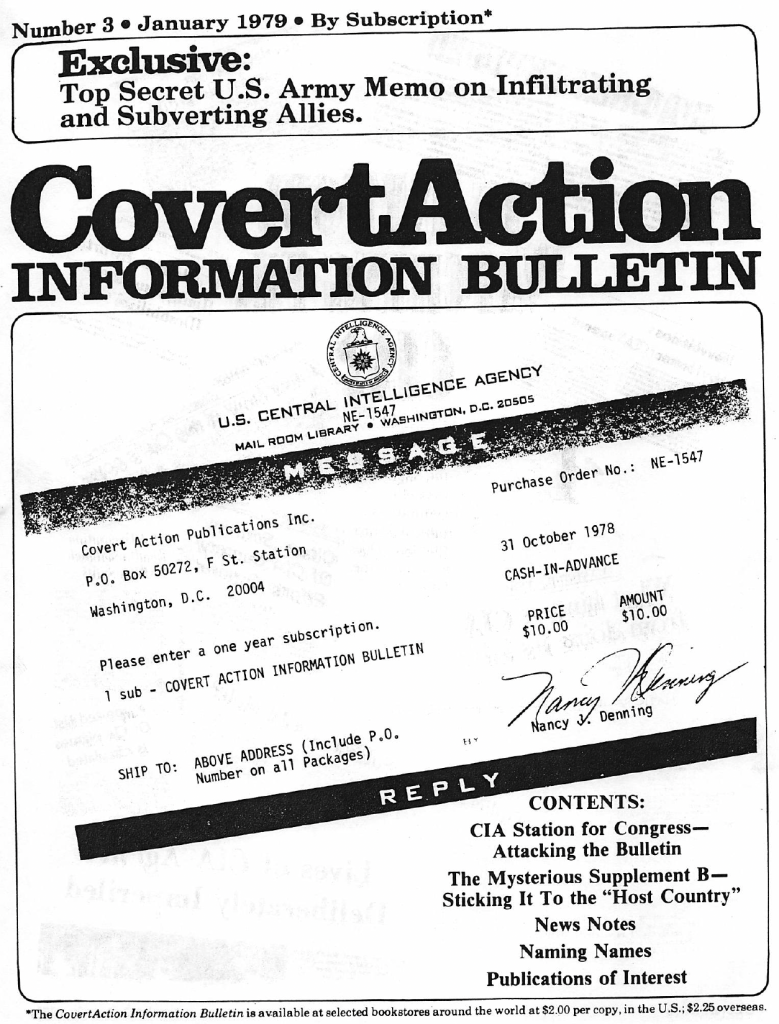
CovertAction Information Bulletin Vindicated by Revelations; Originally Exposed 1970 Manual, which CIA Called a Soviet Forgery, in January 1979 Issue.
Criminal trials and investigations in Europe confirmed that top-secret “Supplement B” to U.S. Army Field Manual 30-31, contrary to the U.S. government’s oft-repeated denials, was indeed an authentic document.
FM 30-31B first surfaced in Europe in the 1970s and was long suspected to be used by U.S. and host countries’ intelligence as operational guidance for violent anti-Communist destabilization, including acts of terrorism.
U.S. intelligence claimed consistently that the document was a sophisticated “Soviet forgery.”
Investigative findings have ultimately vindicated the first assessment of CovertAction Information Bulletin, among the earliest sources to conclude that FM 30-31B was most likely genuine.
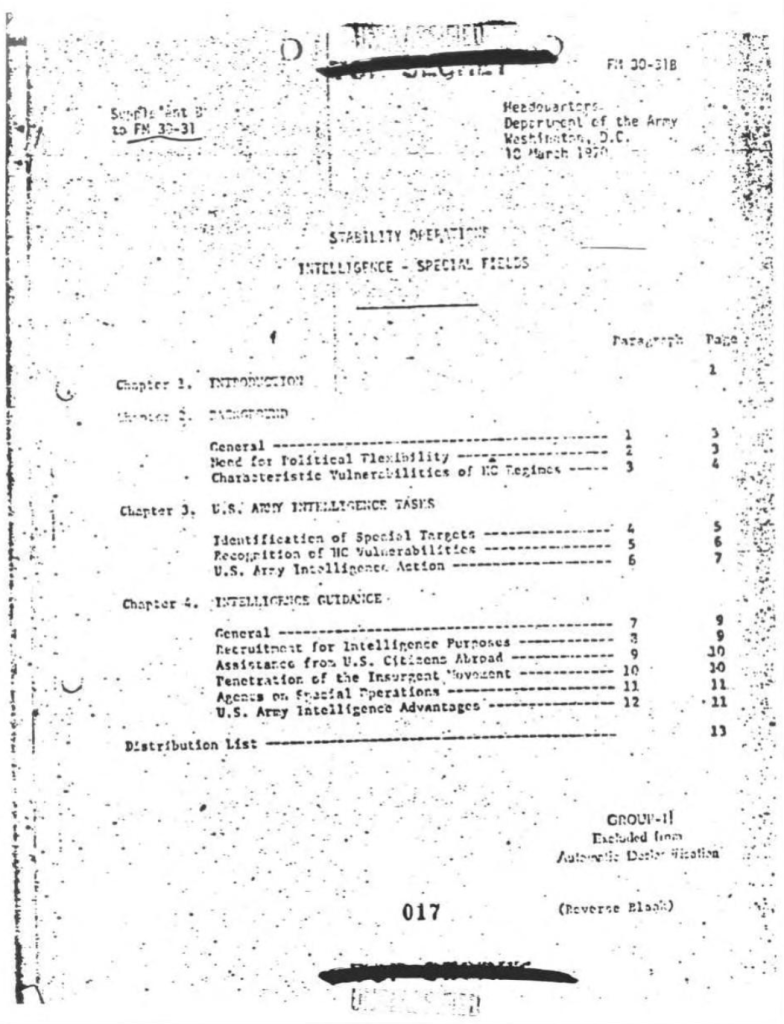
The document in question, the very existence of which is still officially denied, is a classified annex, known as “Supplement B,” to a Field Manual series of the US Army, coded “FM 30-31 Stability Operations—Intelligence.”
FM 30-31 essentially governs the intelligence liaison with countries hosting U.S. troops (HC), with respect to counterinsurgency operations.
The general idea behind it is that HC are friendly to U.S. interests and, absent an external aggression, the greatest security threat to HC would be internal “subversion.”
Dated March 18, 1970, Supplement B to FM 30-31 (“FM 30-31B”) was frequently referred to, eventually, as the “Westmoreland Directive” because it bears the signature of the former Supreme Commander of U.S. Armed Forces in Vietnam, General William Westmoreland.

Since the document was brought to the public’s attention, in the 1970s, it was strongly suspected that FM 30-31B had been used for training and orientation in violent domestic operations, including acts of terrorism.
The controversial nature of “Supplement B” is due to the fact that it calls for and describes highly destabilizing operations in host countries, when the latter show “indecisiveness” in the fight against internal insurgency (to be read, most of the time, against Communism).
A quote from section 11 of FM 30-31B (“Agents on Special Operations”) is indicative: “There may be times when HC governments show passivity or indecision in face of Communist or Communist-inspired subversion/and react with inadequate vigor to intelligence estimates transmitted by U.S. agencies. […]
In such cases, U.S. Army intelligence must have the means of launching special operations which will convince the HC governments and public opinion of the reality of the insurgent danger and of the necessity of counteraction.
To this end, U.S. Army intelligence should seek to penetrate the Insurgency by means of agents on special assignment, with the task of forming special action groups among the more radical elements of the insurgency. When the kind of situation envisaged above arises, these groups, acting under U.S. Army Intelligence control, should be used to launch violent or nonviolent actions according to the nature of the case.” [Emphasis added.]
In retrospect, that quote describes almost exactly what multiple criminal investigations in Europe exposed as a pattern of involvement of intelligence agencies in the activities of extremist groups, responsible for high-profile cases of terrorism during the Cold War.[1]
It is a fact that FM 30-31B first surfaced in either NATO countries (Turkey and Italy), or countries that had a strong political-military alliance with the U.S., such as Spain (the country became a NATO member in 1982).
In January 1979, CovertAction Information Bulletin (C.A.I.B.), the predecessor of CAM, was one of the few U.S. sources to cover the story critically and publish a copy of “Supplement B.”[2]

The CAIB article, which called the document a “guide to imperialist military operations,” is still a very informative source for the background and first analysis of FM 30-31B and can be referred to for that purpose.
While not drawing a definitive conclusion on the authenticity of Supplement B, CAIB was among the first sources to note that all indicators pointed to a positive answer.
Besides the contradictions of official denials, military experts contacted by the magazine unanimously concluded that the document appeared to be genuine.
Following the document’s first exposure, the U.S. government, after an initial, clumsy yet telling, response (the U.S. Embassy in Italy, on one occasion, informed the representative of a respected new magazine, L’Europeo, that the publication of the document would be “inopportune”), was compelled to take more of an explicit stance.
The U.S. State Department and intelligence community have maintained all along that the document is a “singularly effective” Soviet forgery, and there is no “Supplement B” to Field Manual 30-31.
Multiple criminal investigations in Europe, especially in Italy, initiated in the 1980s, would ultimately show otherwise.
The P2 Master, One More Time
It is perhaps unsurprising that Licio Gelli, head of the infamous Masonic Lodge Propaganda 2, better known as P2, should be involved in this matter.
After all, it dovetails perfectly with the role of a U.S.-NATO asset, intimately involved in radical, anti-Communist destabilization throughout the Cold War, that history ultimately made him known for.[3]

Gelli became eternally entangled with the enigmatic “Supplement B” in 1981, shortly after the unraveling of the Propaganda 2 scandal in Italy.
In July 1981, Mariagrazia Gelli, daughter of the Masonic Master, was arrested in Rome, carrying a suitcase with a substantial set of sensitive documents. A copy of FM 30-31B turned out to be one of them. The fact that someone like Gelli was in possession of such a document inevitably set off an endless controversy.
The “Westmoreland Directive” was featured in a segment of the 1992 BBC documentary on Operation Gladio, interviewing Gelli himself and several other top insiders. Gelli was explicit in stating that “a very close friend from the CIA” had given him the document.
CIA officer Ray S. Cline said he “suspect[ed] that it was an authentic document.” Former DCI William Colby, also featured, maintained that “he had never heard of it.”

Michael Ledeen, aide to Alexander Haig, U.S. intelligence asset and holder of strong ties to Italian military secret services, opted to be more assertive, restating the official line that the document was “an old Soviet forgery.”

Considering what is now known about Licio Gelli, and his relationship with the U.S. establishment, the old “Soviet forgery” line has become completely unsustainable.
Certainly, it should not be the word of Gelli, a controversial manipulator par excellence, that we have to take as conclusive evidence. The point is that the links of Gelli to the U.S. political, intelligence and security establishment have been a matter of record for a very long time now.[4]
The most significant evidence will be summarized herein.
Once we get to the now inescapable conclusion that Gelli was indeed a U.S. asset, in the broader fight against Communism, the next logical step toward the authenticity of Supplement B follows closely: We cannot be expected to believe that U.S. intelligence would give its own asset, for ideological orientation and operational purposes, a fake document.
Gelli’s relations with the U.S. military and intelligence establishment actually go back to World War II, when he was recruited by U.S. military counterintelligence.
Gelli was a guest of honor at the inaugurations of Nixon, Ford and Reagan and, as Italian military intelligence chief General Giuseppe Santovito recalled, he was “the only Italian invited to Ronald Reagan’s inaugural lunch.”
As a result of the P2 Lodge scandal, a parliamentary commission of inquiry was established, producing an impressive set of records which corroborate the strong Gelli-U.S. connection.
The documents included, in a folder titled “Alexander Haig,” correspondence between Gelli and Philip Guarino, a prominent Republican operative, dating back to the late 1970s. In it, they were openly discussing how to favor the presidential campaign of Haig, at the time rivaling Reagan’s.
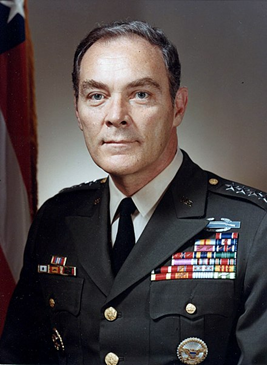
The Supplement B copy seized from Gelli was in an attachment to a letter from one of his U.S. contacts, whose identity has never been established conclusively.[5]
The P2 Commission exhibits also include a secret report from Italian military intelligence, SISMI, dated April 8, 1983, which revealed long-standing ties of Gelli to the U.S. establishment.[6] According to the report, which cites a source within U.S. intelligence, “it was Theodore Shackley that introduced the head of the Masonic Lodge P2, Licio Gelli, to Alexander Haig in the sixties.
The name of Haig [as well as Kissinger’s] surfaced in connection with the P-2 scandal. It was further to the imprimatur of Haig and Kissinger […] that Gelli recruited, in the fall of 1969, as many as 400 high level Italian and NATO officers in the P-2.”
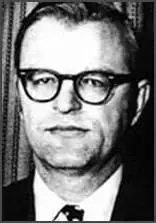
It must be noted that 1969 was a crucial year for the notorious strategy of tension in Italy and the wave of terrorism that ensued.
Yet it was another top-level insider that probably made the most pertinent, yet troubling, remarks on the U.S.-P2 connections.
Francesco Cossiga was a prominent representative of the Italian Christian Democratic Party, President of the Italian Republic between 1985 and 1992, several times a government minister, including prime minister, and a true pillar of the NATO alliance in Italy.
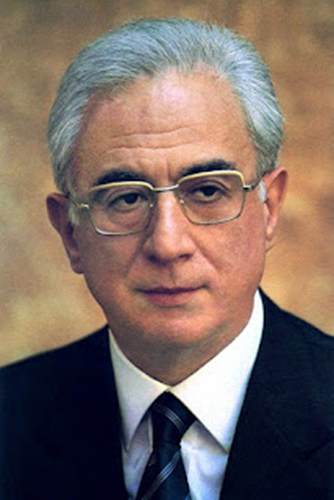
In 1993, speaking to a press gathering in the renowned mountain resort of Cortina d’Ampezzo, Cossiga stunned the audience by claiming that “the P2 was nothing other than ‘an American imported product.’”
“A response, in covert and possibly criminal terms, to the concern in Atlantic circles that a rapprochement between the DC [Christian Democrats] and the PCI [Italian Communist Party] could provoke a cooling in the relationship between Italy and NATO.”[7]
The words of Cossiga, disquieting as they may be, resonate quite well in the context of the Atlantic strategy to keep the Italian Communist Party out of power—whatever the cost.
As if the above-described links were not significant enough, the manner in which Gelli used documents such as the Westmoreland Directive, is also highly revealing of their authenticity.
From the circumstances of the seizure at the Rome airport in 1981, and subsequent comparable episodes involving extremely sensitive records, Italian criminal investigators established early on that Gelli was exploiting such documents for purposes of blackmail and protection.
First, as anticipated, Gelli’s daughter was carrying Supplement B along with other, highly compromising, documents, the veracity of which are not in doubt.
This includes the notorious “Piano di Rinascita Democratica,” essentially a plan to set up a profoundly authoritarian regime in Italy by infiltrating all the levers of power, which is basically what the P2 had started to do, quite successfully.
In the words of judges and prosecutors that investigated this matter, the documents were “hidden” in a highly visible, almost provocative suitcase false bottom, which was clearly encouraging inspection. It could be inferred that Gelli flashed the possession of these documents deliberately.[8]
It was indeed the beginning of an extensive series of veiled hints, when not outright threats.
After his arrest, Gelli started spreading not so subliminal messages to his masters and associates in high circles: He expected to be shielded from prosecution and legal consequences, lest certain sensitive information make its way to public authorities.
The notorious “artigli” (“claws”) matter illustrates the point.
In the 1980s, Gelli was also investigated for his role in obstructing the investigation into the Bologna train station bombing of August 2, 1980, the most serious terrorist attack in Italian history.
However, due to the developments in a connected investigation, a document surfaced (known as “Documento Bologna”) that suggested a darker role of Gelli in the massacre, pointing to his possible responsibility as planner of the bombing.
It was at that moment that Gelli, according to a top-secret report of the Italian police, had his lawyer convey a sinister message to government authorities.[9]
On October 14, 1987, Fabio Dean, Gelli’s famed attorney met with a high-level police official, Umberto Pierantoni, representing the Ministry of the Interior.
According to the police report, Dean hinted, not so subtly, that, if the situation became “exasperated,” then “the few claws Gelli has,” “he will have to use them all.”
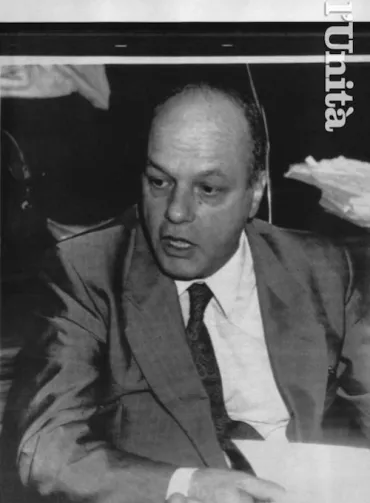
More explicitly, Dean added that, “among the records seized from Gelli in 1982, there are documents with secret information. It will be up to Gelli to endorse them or not, depending on how he will be questioned.” [Emphasis added.]
While the exact follow-up to this bizarre meeting is not known, the strategy proved to be quite effective.
The most damning leads pointing to Gelli, concerning possible direct complicity in planning the Bologna station attack, were not pursued.
It was more than 15 years later that the most sensitive investigation into his role in the Bologna case resumed, leading to two new trials, established after the death of the P2 master (he passed away in 2015).[10]
As previous observers noted poignantly, it is quite hard to see what Gelli could hope to accomplish through such blackmailing schemes, and how they could be successful in the first place—had they been based on fake documents.
The evidence of the authenticity of the “Westmoreland Directive” was becoming overwhelming enough. Yet, that was not to be the end of the story.
The New Investigations on Right-Wing Terror
Additional verification of the truthful nature of FM 30-31B came in the 1990s, as a result of the dogged criminal investigation conducted by Milan Investigating Judge Guido Salvini.
Salvini was looking into the infamous Piazza Fontana terrorist attack of December 12, 1969 (regarded as the beginning of the “Strategy of Tension” in Italy), which caused 17 casualties.
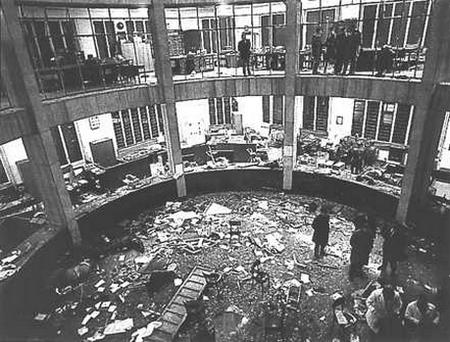
Top insiders interrogated by Salvini turned out to have surprising information on FM 30-31B.
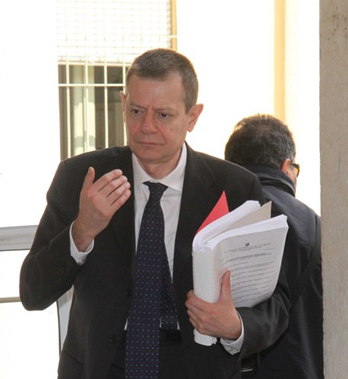
Salvini exposed an extensive connection between a U.S. military-intelligence network, operating around NATO bases in northeast Italy, and operatives from far-right organizations, Ordine Nuovo in particular, which were ultimately responsible for executing terrorist attacks.
The ultimate purpose was to implement a radical policy of destabilization, to prevent Communists from ever seizing power.[11]
The American military-intelligence network investigated by Salvini originated in World War II, particularly with the activity of the Counter Intelligence Corps, and continued, under different structures and individual actors, throughout the most sensitive timeline of the Cold War.
Essentially, the U.S. recruited a number of Nazi-fascist assets in the fight against Communism.
Several names in this network appear in the records declassified as a result of the Nazi War Crimes Disclosure Act, such as that of Nazi SS officer Karl Hass, co-responsible for the Fosse Ardeatine massacre in Italy during WWII.
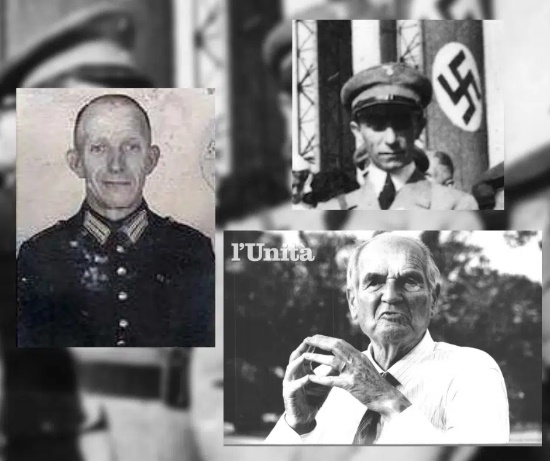

Many Italian right-wing extremists in this group belonged to Ordine Nuovo (frequently cited as “ON”), a radical neo-fascist organization founded in 1956 by ideologue Pino Rauti.
Among them, a key figure is Carlo Digilio. He was the weapons expert of ON and the top insider who made the most sensitive, crucial disclosures to Salvini.
It is by building up and expanding on his depositions, verified through factual and witness corroboration, that Salvini was ultimately able to expose the U.S. network and its relationship to these events.
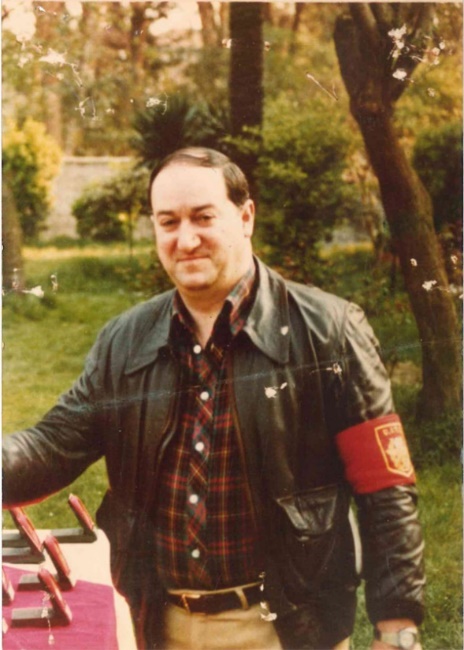
During the extensive interrogation by Judge Salvini, Digilio and other top-level Ordine Nuovo operatives referred repeatedly to a “Westmoreland order” and volunteered information to that effect.[12]
In mentioning the document, Digilio confirmed that it was used as political and operational guidance in the fight against Communism. He also made clear that the ideological and operational tenets associated with the “Westmoreland order,” were largely known in the organization and represented a constant reference in the Cold War strategies of groups such as ON.
Most recent court testimony, heard in the criminal trial on the Bologna station massacre of 1980, confirmed this point.
Now-Colonel Massimo Giraudo, a lead investigator for Judge Salvini, with more than 30 years of experience in anti-terrorism cases, recounted how the policies and goals of the Westmoreland Directive actually governed the actions of Italian right-wing terrorism during the 1970-1980 period.[13]
The troubling nature of these disclosures, it must be noted, transcends the question of the authenticity of FM 30-31B.
The ultimate point is that the strategy and the operational guidelines of the “Westmoreland Directive,” irrespective of the actual origin of the document, were indeed used by U.S.-backed, highly indoctrinated operatives in the most extreme fight against Communism, which did turn out to include the perpetration of grave acts of terrorism.
Evidently, Salvini’s investigation, which continues to be massively under-reported to this day (in Italy as well), was also bitterly opposed at the time.[14] However, the credibility of Salvini’s investigation and witnesses, Digilio in particular, has been confirmed, in the most compelling manner, by subsequent, definitive findings of courts of law.
The evidence and crucial insiders’ depositions first exposed by Salvini, with Digilio’s at the forefront, were particularly instrumental in convicting ON operatives in the criminal trials for the Piazza della Loggia (Brescia) massacre of May 28, 1974.
The focus of these trials was exactly the same network of U.S. and NATO-backed right-wing extremists explored by Salvini. Life sentences were imposed in 2017, and a trial involving NATO directly is currently under way.[15]
Final Act in Bologna
One may well say, at this juncture, that the story of the enigmatic “Supplement B” had been eventful enough. Yet, it turned out that it had one more card to play.
In the most recent criminal trials involving the Bologna train station massacre, Gelli was investigated as the planner and financier of the terrorist attack.[16] It is only his death in 2015 (at the age of 96) that shielded him from criminal conviction.

The new Bologna investigations inevitably sparked a renewed interest in the original P2 scandal and the actual track record of Licio Gelli.
This led to a most significant contribution to our case, the testimony of General Pasquale Notarnicola.
Heard by Bologna prosecutors in October 2018, General Notarnicola made critical disclosures regarding the veracity of the notorious Supplement B.[17]
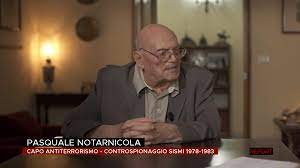
Notarnicola was head of the counterterrorism division of Italian military intelligence (SISMI) in the 1978-1981 period, a sensitive time in Italy’s Cold War history.
The general revealed that, in 1981, as soon as it was known that the field manual copy had been seized from Gelli, he had this issue investigated in the SISMI archives. The archival search promptly returned a copy of FM 30-31B. According to Notarnicola “there was no question at SISMI that the document was genuine, actually received from U.S. authorities.”
Notarnicola was certain of this also because “there was no service note indicating that the document could be false.”
The general explained that, when SISMI doubted the authenticity of a document, it was standard operating procedure to attach a dubitative mark (“floating”) to it.
This was not the case for the manual supplement copy in question, which bore no such mark.
With this clarification in mind, there is hardly any question that the FM 30-31B copy held at SISMI archives originated from an authentic document.
It is a matter of record that, dating back to the end of WWII, the relationship between U.S. and Italian military (and intelligence) was institutional and hierarchical.
The Italian military intelligence service (known as “SIFAR” at its creation), was founded in 1949, in close cooperation with the CIA, almost simultaneously with Italy’s official affiliation to NATO (possible only because the powerful Italian Communist Party, following its loss in the crucial 1948 election, had been completely excluded from any government participation.)[18]
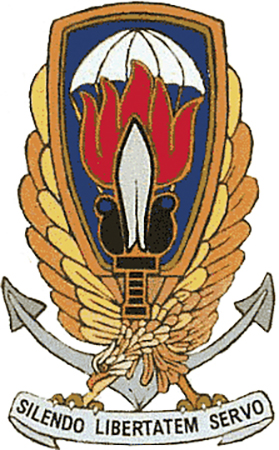
From the outset, SIFAR, SISMI’s predecessor, was governed by a secret protocol that imposed a strong subordination of Italian military intelligence to NATO and the CIA.[19]
Most significantly, it was the “Office R” of SIFAR that would run, in coordination with NATO, the clandestine anti-Communist “stay-behind” operation, known in Italy as Gladio.
This structural, operative relationship between U.S. and Italian military forces and intelligence services, largely conceived in extreme anti-Communist terms, by definition extended to training and cooperation in special counterinsurgency operations.
It is therefore inconceivable that the FM 30-31B copy in the SISMI archive (absent the exception, not applying, noted by Notarnicola) would be from a spurious source.
In the ultimate analysis, the revelations of General Notarnicola fell perfectly into place with an established record of U.S.-backed radical anti-Communism, spanning the entirety of the Cold War.
A most sustained government deception has finally come to its end.
Yet exactly when, how and where else FM 30-31B was used, and with what consequences, must still be told.

-
On the possible connection of FM 30-31B to U.S. and NATO-backed violent anti-Communist destabilization, see Daniele Ganser, NATO’s Secret Armies: Operation GLADIO and Terrorism in Western Europe (New York: Routledge, 2005), especially chapter 17. ↑
-
CovertAction Information Bulletin, “The Mysterious Supplement B; Sticking It to the ‘Host Country’”, no. 3, January 1979, p. 9. ↑
-
In general terms, the story of Licio Gelli and the P2, otherwise still largely unwritten, is known but cannot be recounted here. In the English language, a good reference source is Philip Willan, Puppetmasters: The Political Use of Terrorism in Italy (Bloomington, IN: iUniverse, 2002). ↑
-
For an informative English-language review of the relationship between the P2 Master and the U.S., see Willan, Puppetmasters, chapter 4, titled not coincidentally “Gelli and America.” ↑
-
The letter and the FM 30-31B copy are available in the P2 Commission exhibits, “Doc.XXIII no.2-quarter,” Vol. VII, I, pp. 283 and ff. The signature of the letter is not clearly legible. ↑
-
In P2 Commission exhibits, “Doc. XXIII no. 2-quarter,” Vol. VII, V, pp. 315 and ff. ↑
-
La Repubblica, “Ma il capo della P2 non era Licio Gelli,” August 24, 1993. ↑
-
The extensive blackmailing strategy orchestrated by the Masonic leader was recounted, as recently as 2022, by the Judges in charge of the investigation into the Bologna station bombing of 1980 (see infra). ↑
-
See Criminal Judgment against Paolo Bellini and others, Court of Bologna, April 6. 2022 (decision grounds filed on April 5, 2023), pp. 756-757. ↑
-
It must be noted that, even for his definitive criminal convictions, Gelli did not serve one day of actual prison time. Further to his initial arrests, a long period of fugitive life ensued, and Gelli returned to Italy when his legal situation was largely settled. The little time he served was at his hyper-luxurious Tuscan Villa. ↑
-
See the Criminal Indictment filed by Prosecutor Salvini, Tribunal of Milan, “Sentenza-Ordinanza” in the criminal proceeding against Rognoni Giancarlo and others, February 3, 1998, especially its part V, related to the U.S. network, pp. 275 and ff.
This criminal investigation, not surprisingly, is almost entirely unknown in the U.S. English-language works citing it are also extremely limited. A notable exception may be Anna Cento Bull, Italian Neofascism: The Strategy of Tension and the Politics of Nonreconciliation (Oxford, NY: Berghahn Books, 2011). It must be noted, however, that Bull’s research does not benefit from the subsequent judicial developments, which definitively corroborated the conclusions by Salvini. See also Ganser, NATO’s Secret Armies. ↑ -
Salvini, Criminal Indictment, p. 348, which refers to multiple interrogatories of Digilio and other insiders. In the original Italian, Digilio mentioned an “ordinanza Westmoreland,” which literally translates as “order.” ↑
-
See Criminal Judgment against Paolo Bellini, pp. 880-883. ↑
-
Salvini was harshly attacked politically, but also by his own colleagues in the Judiciary. As noted, history has completely vindicated his inquiry. Salvini is still a successful prosecutor and his extensive expertise in anti-terrorism earned him important consultant positions in Parliamentary Commission of Investigation, including the latest inquiry on the Aldo Moro affair. Salvini also authored a fundamental book on the Piazza Fontana attack, which represents the most complete account of the investigation: La Maledizione di Piazza Fontana, Chiarelettere, 2019. ↑
-
See the Criminal Judgment against Maggi and Tramonte, Corte Suprema di Cassazione, June 20, 2017;
La Repubblica, “Strage di Brescia, il processo senza fine – chiesto il giudizio per due neofascisti,” October 22, 2022. ↑ -
Two first-instance judgments, handed down in January 2020 and April 2022, respectively, explicitly accused the late P2 Master of being indeed a leading culprit of the operation. See Criminal Judgment against Gilberto Cavalllini, Court of Bologna, January 9, 2020 (decision grounds filed on January 7, 2021), and Criminal Judgment against Paolo Bellini ↑
-
On June 23, 2021, in compliance with procedural rules, the entire interrogatory of General Notarnicola was read in Court and entered into the Bellini trial record. ↑
-
Careful observers noted that “the contemporaneous joining of NATO and reinstatement of an intelligence capability was more than mere coincidence…and gives an insight into the fundamental purpose of the post-war Italian secret service in the intentions of those who sanctioned its rebirth.’” Willan, Puppetmasters, p. 34. ↑
-
For an English-language overview, see Ganser, NATO’s Secret Armies, pp. 66-67. ↑
CovertAction Magazine is made possible by subscriptions, orders and donations from readers like you.
Blow the Whistle on U.S. Imperialism
Click the whistle and donate
When you donate to CovertAction Magazine, you are supporting investigative journalism. Your contributions go directly to supporting the development, production, editing, and dissemination of the Magazine.
CovertAction Magazine does not receive corporate or government sponsorship. Yet, we hold a steadfast commitment to providing compensation for writers, editorial and technical support. Your support helps facilitate this compensation as well as increase the caliber of this work.
Please make a donation by clicking on the donate logo above and enter the amount and your credit or debit card information.
CovertAction Institute, Inc. (CAI) is a 501(c)(3) non-profit organization and your gift is tax-deductible for federal income purposes. CAI’s tax-exempt ID number is 87-2461683.
We sincerely thank you for your support.
Disclaimer: The contents of this article are the sole responsibility of the author(s). CovertAction Institute, Inc. (CAI), including its Board of Directors (BD), Editorial Board (EB), Advisory Board (AB), staff, volunteers and its projects (including CovertAction Magazine) are not responsible for any inaccurate or incorrect statement in this article. This article also does not necessarily represent the views the BD, the EB, the AB, staff, volunteers, or any members of its projects.
Differing viewpoints: CAM publishes articles with differing viewpoints in an effort to nurture vibrant debate and thoughtful critical analysis. Feel free to comment on the articles in the comment section and/or send your letters to the Editors, which we will publish in the Letters column.
Copyrighted Material: This web site may contain copyrighted material the use of which has not always been specifically authorized by the copyright owner. As a not-for-profit charitable organization incorporated in the State of New York, we are making such material available in an effort to advance the understanding of humanity’s problems and hopefully to help find solutions for those problems. We believe this constitutes a ‘fair use’ of any such copyrighted material as provided for in section 107 of the US Copyright Law. You can read more about ‘fair use’ and US Copyright Law at the Legal Information Institute of Cornell Law School.
Republishing: CovertAction Magazine (CAM) grants permission to cross-post CAM articles on not-for-profit community internet sites as long as the source is acknowledged together with a hyperlink to the original CovertAction Magazine article. Also, kindly let us know at info@CovertActionMagazine.com. For publication of CAM articles in print or other forms including commercial internet sites, contact: info@CovertActionMagazine.com.
By using this site, you agree to these terms above.
About the Author
Denis Voltaire is a researcher from France who has studied and worked in Washington, D.C.



